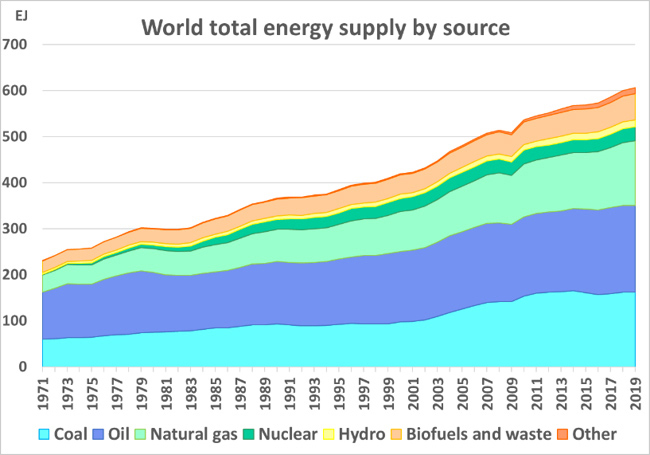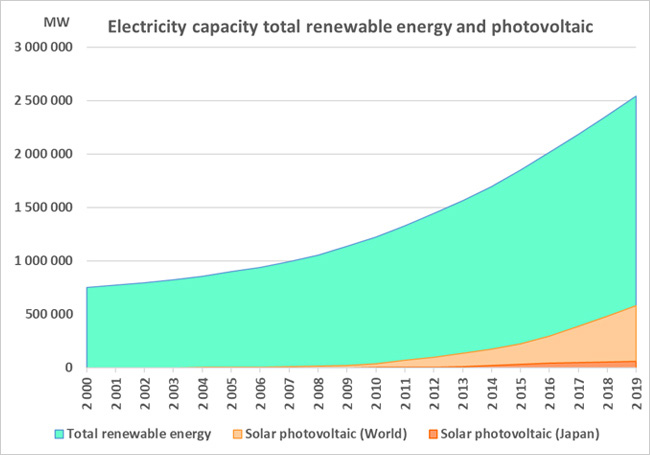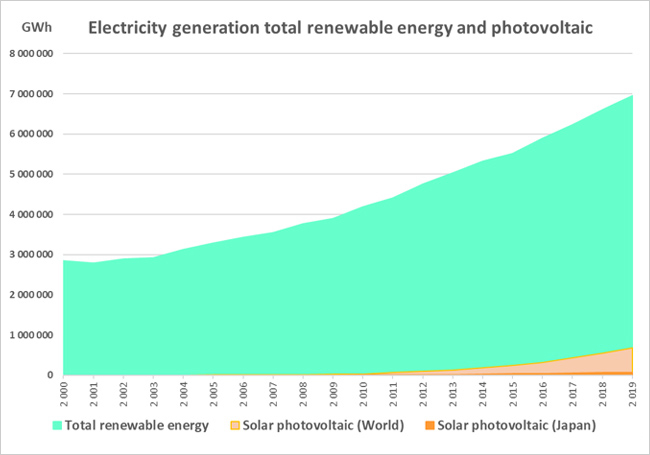PV column
energy
2022/03/01
The trend of energy consumption and photovoltaics

All rights reserved; as modified by Europe Solar Innovation Co., Ltd.
Energy consumption is increasing around the world due to population growth and economic development, and the amount of renewable energy is also increasing rapidly. According to the energy statistics data published by the International Energy Agency (IEA), the world total energy supply by source as follows:
World energy supply has increased from 230 EJ in 1971, 422 EJ in 2001, and 606 EJ in 2019. (EJ, exajoules, Quintillion: 1018).
The largest energy source is oil (102 EJ in 1971, 155 EJ in 2001, and 187 EJ in 2019), and the 2nd largest is coal (60 EJ in 1971, 98 EJ in 2001, and 162 EJ in 2019), oil and coal account for more than 50% of the world’s energy supply.
The 3rd largest energy source is natural gas (37 EJ in 1971, 87 EJ in 2001, 140 EJ in 2019), the 4th is biofuels and waste-derived fuels, the fifth is nuclear (1.2 EJ in 1971, 28.8 EJ in 2001, 30.5 EJ in 2019), and renewable energy like hydro, wind, PV and other energy sources were 4.5 EJ in 1971, 11.8 EJ in 2001, 28.6 EJ in 2019.

The excerpt of the Energy White Paper released by the Agency for Natural Resources and Energy (ARENA) in the Japanese Ministry of Economy, Trade and Industry (METI) regarding energy supply sources and consumption is as follows:
“Specifically, the primary energy supply is original forms such as oil, natural gas, coal, nuclear, solar, wind, etc., whereas the final energy consumption becomes different forms such as petroleum products (gasoline, kerosene, fuel oil, etc.), utility gas, electricity, heat and so on. Looking at the flow of primary energy by source, most of the nuclear, renewable and other energy sources were converted into electricity and consumed. On the other hand, a large proportion of natural gas was not only converted into electricity, but also into utility gas with adjusted heat (calory) and consumed. Regarding oil, a relatively small proportion was converted to electricity, most of which was consumed through the process of oil refining, as transport fuels such as petrol and diesel, petroleum products such as kerosene and heavy oil, and naphtha for petrochemical feedstock. Regarding coal, a large proportion was converted to electricity and used as a raw material for coke, which is necessary for steelmaking.”
Meanwhile, the installation of renewable energy is also increasing due to the focus on CO2 reduction, SDGs, etc.
The database of the International Renewable Energy Agency (IRENA) shows the trends of power plant capacity and generation as follows:
The world’s renewable power plant capacity in 2000 is 753,288 MW.
The largest capacity power plant is Hydroelectric and its amount is 697,319 MW, and the amount of pumped storage plants, which are not included in the statistics for renewable energy, is 84,931 MW.
The capacity of wind power plant is 16,932 MW, while the capacity of PV power plant (excluding concentrating PV power plant) is 809 MW (of which 330 MW is in Japan), only 0.1% of the total.

As of 2019, the capacity of renewable energy power plant becomes 2,542,035 MW worldwide. The largest capacity is still hydroelectric and its amount is 1,191,570 MW, and the amount of pumped storage plants is 120,599 MW, which are not included in the statistics of renewable energy. The capacity of wind power plant becomes 621,646 MW, and the capacity of PV power plant (excluding concentrating solar power plant) is increased significantly to 583,872 MW, or 23.0% of the total (including 63,192 MW in Japan).
As of 2000, the amount of electricity generation from renewable energy power plants worldwide was 2,843,533 GWh, and the largest amount was hydroelectric (2,626,417 GWh), 83,215 GWh from pumped storage plants, which are not included in the statistics of renewable energy. Wind power plants generated 30,918 GWh, and PV power plants (excluding concentrating solar power plants) generated an even smaller share of the total, 0.03% or 805 GWh (including 357 GWh in Japan).
As of 2019, the amount of electricity generation from renewable energy power plants was 6,963,450 GWh worldwide. The largest amount of electricity was generated by hydroelectric power plants at 4,207,127 GWh, and 114,480 GWh was generated from pumped storage power plants, which are not included in the statistics for renewable energy.
Wind power plants generated 1,412,384 GWh, and PV power plants (excluding concentrating solar power plants) increased to 678,999 GWh, 9.75% of the total (68,953 GWh came from Japan.)
Renewable energy as energy source as of 2019 becomes 4.72% of the total (28.6 EJ of 606 EJ), and the electricity generation by PV power plant becomes 9.75% of total renewable energy generation, and estimated 0.46% of total energy supply resource.
Source: IEA, World Energy Balances, 2021.
https://www.iea.org/data-and-statistics/charts/world-total-energy-supply-by-source-1971-2019
Source: IRENA, Data & Statics.
https://www.irena.org/Statistics
Source: White paper on Energy 2021, Agency for Natural Resources and Energy in Japan
https://www.enecho.meti.go.jp/about/whitepaper/2021/pdf/

